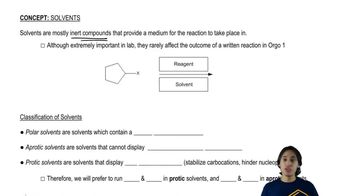a. Which is a stronger base: RO− or RS−?
b. Which is a better nucleophile in an aqueous solution?
c. Which is a better nucleophile in DMSO?
 Verified step by step guidance
Verified step by step guidance Verified video answer for a similar problem:
Verified video answer for a similar problem:



 6:21m
6:21mMaster Understanding the difference between basicity and nucleophilicity. with a bite sized video explanation from Johnny
Start learning